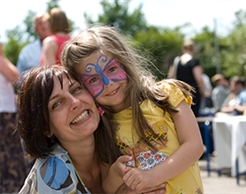Creative thinking in kids: Charlie and Lola author Lauren Child's top tips
There aren't many parents who haven't heard their child utter the immortal phrase "I'm bored".
But instead of desperately scrambling to entertain them, parents should welcome their child's boredom, suggests Lauren Child, the author and illustrator who created the much-loved Charlie and Lola books.
Child believes daydreaming or just staring into space can foster creativity, which is vital for children's development.
"Don't be afraid to allow your child to be bored," she stresses.
"Boredom is often a time when inspiration comes and when children start to work things out for themselves."
Lauren, the Waterstones Children's Laureate who also gave young readers the Clarice Bean and Ruby Redfort books, has launched a campaign, called Staring Into Space.
Through this, she is urging parents and teachers to foster creative thinking in children by helping them spend some time simply looking, listening, staring into space and making things.
Creative thinking, she says, helps children to problem solve, and understand who they are and how they relate to others and the world.
"It is now widely recognised that creativity is as important as literacy or numeracy, and that allowing ourselves the time, space and freedom to be creative is essential for good mental health. Sometimes we need to stare into space."
Here are her top five suggestions for inspiring creativity...
1. Stop...and think about nothing
Try, with your child, to take 15 minutes every day to put things down - work, laptop, toys - and just think about nothing and allow your mind to clear.
"For me, this is when I get most of my ideas and when thoughts are allowed to collide," explains Child.
Parents should sometimes let kids just stare into space, she says, simply allowing their minds to drift and daydream. "Daydreaming is connected to creativity and allows ideas space to emerge and play."
2. Phones down for everyone!
"We need to try and put our phones down as parents so children can see we're doing this and leaving our phones for a while. The benefit of this is again to have time to clear our minds but also to communicate with people face-to-face.
"Often, we miss kind and everyday interactions with people because we're so busy looking at our devices."
Lauren suggests everyone in the family tries not to have phones or devices with them at mealtimes so texts or e-mails, however urgent they may seem, aren't interrupting conversations. Instead, the time can be used to share ideas and thoughts.
"How can we persuade ourselves that it's worth the effort to look away? That when we turn our attention wholly away from the device, we will be rewarded?" asks Lauren.
"I am trying to train myself to put my phone away and out of mind until it's really needed: no idle texting, no calls, no checking Instagram or e-mails, and the camera only to be used when I see something I feel I truly want to keep. In truth, it's hard. But I am convinced it's worth it."
3. Don't delay creativity
If your child suggests doing something creative, try and react to them immediately. Part of you wants to say ' not now' and 'please don't make a mess', but try to see this as time for bonding and communication.
Child says that if her daughter, Tuesday, wants do some cooking or make something, "I always try to go along with this if we've got the ingredients and the things we need, even if we've only got 10 minutes.
"I think this can make a big difference. As a child, your enthusiasm wanes if someone says, we can do that later or next weekend."
4. Look carefully
Child suggests walking outside, looking at things and discussing them with your child.
"It sounds really obvious, but often we're trying to get somewhere and don't take the time.
"My daughter and I often discuss things we see dropped on the street or we take pictures of buildings and then zoom in on the patterns and go home and try and sketch them."
5. Try making sculptures from toast
Lauren has worked with arts and crafts teacher Josey Scullard and BookTrust to outline six creative resources, linked to children's books, for children to try. One of these is making toast sculptures, inspired by A World of Your Own by Laura Carlin which encourages readers to look beyond the surface of things and see them in a different way.
"So here is a chance to look and think in an upside down, inside out sort of way," Lauren tells young creators.
"You could lie on the floor and imagine the ceiling as your floor. Look at the small things in your pockets, bags, or on the shelves; what other things could they be? Let your imagination run riot."
As kids' ideas grow, they will be ready to start building their world out of toast - stale, slightly toasted works best.
To create the toast sculptures, first sketch your ideas and then use about four pieces of toast, cut into a smaller sizes if you like, to make walls.
Think beyond the average size and shape of a piece of toast, and try bending it to make curves and twists, or cut it into small pieces for bricks or cladding. Use pastry cutters or bottle tops to cut windows and doors (they don't have to be square, they can be circles or hearts).
Finally, attach the toast together by pushing cocktail sticks through both pieces, and snip off the ends of the sticks if they're poking out. Flat pieces could even be stuck together carefully with a little golden syrup.




